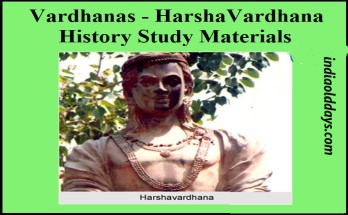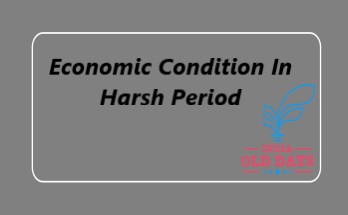Harsh’s administration
Besides being a conqueror and empire builder, Harsh was also a skilled administrator. We get the knowledge of his governance system with the description of Baan’s in Harshcharit and Hunsang’s travel details of his articles. It is worth mentioning here that Harsh did not give rise to any new system of governance, But he adopted the Gupt governance system with some modifications and changes. Even the names of departments and employees of the government appear to be the same.
The emperor
Even in Harsh’s time, the form of governance was monarchical. The king believed in his daivee origin. He used to hold great titles like Maharajadhiraj, Parambhattarak, Chakravarti, Parameshwar. In Harshacharit, Harshavardhan has been called the embodiment of all the gods. Comparing him with Shiva, Indra, Yam, Varun, Kuber etc, the emperor is said to be superior in all. It is worth mentioning that after the Maurya period, the spirit of the incarnation of Godhead in the kingdom was fully established by this time. He was the supreme officer of the administration. The emperor was the head of the executive, the chief justice of justice and the army’s greatest commander. However, despite having great titles and power, Harsh is not autocratic. His kingship ideal was very high. Following the orders of ancient scriptures, he made the protection and observance of the subjects his highest goal.
In the donation letters of Banskhera and Madhuban, Harsh expresses his feelings like this –
The fruit of Lakshmi lies in donating and protecting the fame of others. Human beings should take care of beings with mind, speech and deeds. This is the best means of virtue. Like Chandragupt and Ashoka, Harsh personally participated in various functions of governance.
Huesang tells us that the whole day of Harsh was divided into three parts. first part he used to do administrative work. and Remained in religious work in the remaining two parts. He was tireless and spent a very short day for these tasks. Harsh used to visit different parts of the empire to know the condition of his subjects. Temporary residences were built on such occasions for his stay, which was called Jayaskandhavar. Banskhera and Madhuvan Lakes, there are references to Vardhamankoti and Kapithika Jayaskandhavar respectively. Another Jayaskandhavar was at Manitara situated on the banks of the river Achiravati. It was here that Baan was first met with Harsh.
Feudal and Council of Ministers
The subordinate ruler of Harsh was called Maharaj or Mahasamant. Feudal lords had a special place in administration. Various types of feudal are mentioned in Harshacharit and Kadambari, Such as – Feudal, Mahasamant, Apte Feudal, Principal Feudal, Enemy Feudal and Prati Feudal. According to Harshacharit, Harsh had made the Mahasamantas his debt. The names of Mahasamant Maharaj Ishwargupt are found in the writings of Bansakhera and Madhuban. He would be present in his Rajya Sabha at time, participate in various ceremonies and give military assistance to the emperor on the occasion of wars. By the time of Harsh, the word Feudal’ was being used for landlords, subordinate kings and high officials.
are found in the writings of Bansakhera and Madhuban. He would be present in his Rajya Sabha at time, participate in various ceremonies and give military assistance to the emperor on the occasion of wars. By the time of Harsh, the word Feudal’ was being used for landlords, subordinate kings and high officials.
Positions like Amatya and Kumaramatiya also became feudal warriors. The Aehole article shows that Harsh’s army consisted of big feudals. The Aapt Samanta were those who voluntarily accepted the subordination of their masters. The enemy feudatories were semi-independent princes. The meaning of the prati feudal is not clear. R.S. Sharma considers them to be antagonistic or imperishable feudal lords of the king. According to Devaahuti it refers to the feudatories of enemy kings. Thus it is clear that the Harsh period administration had become more feudal and decentralized than before.
There was also a Council of Ministers to provide assistance to the emperor. The minister was called Secretary or Amatya. During Harsh’s time, Bhandi was his Principal Secretary. Even on important questions like succession, the State of the Council of Ministers was considered necessary. After Rajyavardhan’s death, Bhnji convened a meeting of the Council of Ministers to decide the succession question. His foreign secretary was Avanti. The Secretary of State’s Foreign Secretary was Mahasandhivigrahika. He had to declare war and peace.
Harshcharit reveals that Harsh had made this announcement through Avanti, That all the rulers either accept the emperor’s subordination or submit to war. Sinhnaad was its chief commander. He was employed since the time of Prabhakarvardhan. He successfully conducted many wars and his royalty was remarkable. He had a highly respected place in governance. Kuntal was the highest officer of the ashwarohi army and Skandagupt was the head of the Gaj army. Rajasthaneey was probably Viceroy or Governor. Huensang’s description shows that ordinarily ministers and central employees were not paid cash, instead they were given land blocks, But military officers used to get cash salary. He writes that every governor, minister, magistrate and officer had got land to run personal expenses. These types of officers may include dausaadhasaadhanikon, pramatars, Rajasthanis, servants and subject matter, which are mentioned in the articles of Harsh. It is clear that now the revenue in the form of grant was given not only to the priests and scholars but also to the administrative officials. This practice is also confirmed by the lack of coins in that period.
Administrative Department and Officer-
For the convenience of administration, Harsh’s big empire was divided into several provinces. But the number of the provinces of harsh period is not known. The word Lokpal has come for the provincial ruler in Harshacharit. The province was called Bhukti. The ruler of each Bhukti was called Rajasthani, Upper or National. The articles of Madhuban and Banskhera bear the names of Kundadhāni and Angdiya subjects respectively. Bhukti was divided into districts. Which was the noun, the subject whose head was the subject. There were many readers inside the subject, who were equal to the present day tehsils.
The village was the smallest unit of governance. The head of the village government was called Gramakshapatrik. There were many Karneek to help him. The names of some other officials are found in the literature and writings of Harsh period, Such as – Mahtara, Dausdasadhikanik, Pramatar, Bhogik etc. But it is difficult to say with certainty about their real knowledge. Among them, Mahatar was the head of the village. Dausadasadhyanik literally means one who completes a difficult task. Some people consider it to be the gatekeeper or gramadhyaksha. The pramaataar is related to the measurement of land, While there may have been some officer related to the Revenue Department. In Harshacharit, there is a mention of the writer and the longevity. These appear to be messengers. Kumaramatya, messengers, divir etc. are also mentioned. Kumaramatya was a class of high officials in the Gupta administration, who could serve in any position. The same situation must have happened in Harsh period. The envoy was often a high-ranking minister. Sometimes people belonging to families were also kept in this post. Their main task was to get the land transferred to the beneficiary. Divir was also called a writer. Its position was also similar to that of Amatya.
No forced labor was taken from the people. Huensang writes that governance was conducted in honest. Traffic on roads was not completely secure. Huanseang himself was trapped in the clutches of thief bandits several times. He writes that one time he was traveling by the river Ganges, pirates surrounded him. They chose him to sacrifice Goddess Durga. Then a storm came, which saved his life. This was not the case during the time of Chandragupt Maurya or Chandragupt II. We learn that Fahyan visited India safely.
Penal law
There was a system of severe punishment for crimes. The Seditious were given life imprisonment. This suggests that the detainees were treated mercilessly. The Penitentiary was stricter than the Gupta period. Nose, ears, hands, feet etc. were cut off in crimes against social morality. Criminals were also expelled from outside the country. To prove the culprit innocent, divine tests were also taken with fire, water and poison.
Police Department was established to maintain peace and order in the country. Police personnel are called chaat or bhaat. The convicts and officers of the criminal police department used to be.
Revenue
Harsh’s administration was moderate and soft. Very few taxes were levied in the empire. Only three taxes are mentioned in the copper days of Harsh –
- Bhaag– Bhaag was land tax. It was the main source of income of the state and the farmers used to get their 6th share of their produce.
- Hiranya – Hiranya tax used to take cash, which was given by the merchant.
- Bali – Nothing is known about Bali tax. It looks like it must be doing a religious tax.
Taxes were also levied on trade routes, ghats, sale items etc. The state received enough money from these taxes. There is also a mention of a tax called Tulyamey, Which was applied on objects according to weight and measurement. Money was also received in the form of fine. The income from state land was spent in four ways. Its first part of it was spent in religious and governmental activities, the second part on top of the royal officials, the third part in awarding scholars and the fourth part was donated to various sects.
Hiuensang tells us that if there was a problem in a city or village, the emperor immediately went there. Except the rainy season, Harsh used to visit from one place to another in the remaining three seasons, Where people used to tell about his sufferings. The writings reveal two such places, where Harsh stayed during his travels – Vardhmanakoti and Kapiththika. Donations of Banskhera and Madhuban respectively were broadcast from these places.
Army
Harshvardhan had a large and organized army. This is confirmed by the description of the Harscharit and Huan Tsang of the Baan. Harshacharit reveals that at the time of his journey to Digvijay, Harsh’s number of soldiers was so large that he was surprised to see the huge army group gathered in front of him. According to Huanseang, there were 60 thousand elephants and one lakh horses in his army. The number of foot soldiers would also have been quite large.
Reference : https://www.indiaolddays.com



